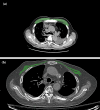Thoracic skeletal muscle quantification using computed tomography and prognosis of elderly ICU patients
- PMID: 34873225
- PMCID: PMC8648749
- DOI: 10.1038/s41598-021-02853-4
Thoracic skeletal muscle quantification using computed tomography and prognosis of elderly ICU patients
Abstract
In elderly ICU patients, the prevalence of skeletal muscle loss is high. Longitudinal effect of thoracic muscles, especially in elderly ICU patients, are unclear although skeletal muscle loss is related with the short- and long-term outcomes. This study aimed to evaluate whether pectoralis muscle mass loss could be a predictor of prognosis in elderly ICU patients. We retrospectively evaluated 190 elderly (age > 70 years) patients admitted to the ICU. We measured the cross-sectional area (CSA) of the pectoralis muscle (PMCSA) at the fourth vertebral region. CT scans within two days before ICU admission were used for analysis. Mortality, prolonged mechanical ventilation, and longitudinal changes in Sequential Organ Failure Assessment (SOFA) scores were examined. PMCSA below median was significantly related with prolonged ventilation (odds ratio 2.92) and a higher SOFA scores during the ICU stay (estimated mean = 0.94). PMCSA below median was a significant risk for hospital mortality (hazards ratio 2.06). In elderly ICU patients, a low ICU admission PMCSA was associated with prolonged ventilation, higher SOFA score during the ICU stay, and higher mortality. Adding thoracic skeletal muscle CSA at the time of ICU admission into consideration in deciding the therapeutic intensity in elderly ICU patients may help in making medical decisions.
© 2021. The Author(s).
Conflict of interest statement
The authors declare no competing interests.
Figures


Similar articles
-
Reference values of skeletal muscle area for diagnosis of sarcopenia using chest computed tomography in Asian general population.J Cachexia Sarcopenia Muscle. 2022 Apr;13(2):955-965. doi: 10.1002/jcsm.12946. Epub 2022 Feb 15. J Cachexia Sarcopenia Muscle. 2022. PMID: 35170229 Free PMC article.
-
Acute reduction of erector spinae muscle cross-sectional area is associated with ICU-AW and worse prognosis in patients with mechanical ventilation in the ICU: A prospective observational study.Medicine (Baltimore). 2021 Nov 24;100(47):e27806. doi: 10.1097/MD.0000000000027806. Medicine (Baltimore). 2021. PMID: 34964749 Free PMC article.
-
Skeletal muscle quality as assessed by CT-derived skeletal muscle density is associated with 6-month mortality in mechanically ventilated critically ill patients.Crit Care. 2016 Dec 1;20(1):386. doi: 10.1186/s13054-016-1563-3. Crit Care. 2016. PMID: 27903267 Free PMC article.
-
Skeletal muscle predicts ventilator-free days, ICU-free days, and mortality in elderly ICU patients.Crit Care. 2013 Sep 19;17(5):R206. doi: 10.1186/cc12901. Crit Care. 2013. PMID: 24050662 Free PMC article.
-
Low skeletal muscle area as a prognostic marker for chronic obstructive pulmonary disease in elderly patients admitted to ICU.Sci Rep. 2019 Dec 13;9(1):19117. doi: 10.1038/s41598-019-55737-z. Sci Rep. 2019. PMID: 31836824 Free PMC article.
Cited by
-
Cluster analysis of thoracic muscle mass using artificial intelligence in severe pneumonia.Sci Rep. 2024 Jul 23;14(1):16912. doi: 10.1038/s41598-024-67625-2. Sci Rep. 2024. PMID: 39043882 Free PMC article.
-
Prevalence and prognostic value of preexisting sarcopenia in patients with mechanical ventilation: a systematic review and meta-analysis.Crit Care. 2022 May 16;26(1):140. doi: 10.1186/s13054-022-04015-y. Crit Care. 2022. PMID: 35578299 Free PMC article.
-
Prevalence and mortality risk of low skeletal muscle mass in critically ill patients: an updated systematic review and meta-analysis.Front Nutr. 2023 May 12;10:1117558. doi: 10.3389/fnut.2023.1117558. eCollection 2023. Front Nutr. 2023. PMID: 37252244 Free PMC article.
-
Thigh muscle mass evaluated by point-of-care ultrasound is associated with short-term mortality in patients with sepsis in the emergency department.Sci Rep. 2024 Jun 4;14(1):12776. doi: 10.1038/s41598-024-63769-3. Sci Rep. 2024. PMID: 38834760 Free PMC article.
-
Elderly Patients and Management in Intensive Care Units (ICU): Clinical Challenges.Clin Interv Aging. 2023 Jan 22;18:93-112. doi: 10.2147/CIA.S365968. eCollection 2023. Clin Interv Aging. 2023. PMID: 36714685 Free PMC article. Review.
References
MeSH terms
LinkOut - more resources
Full Text Sources

